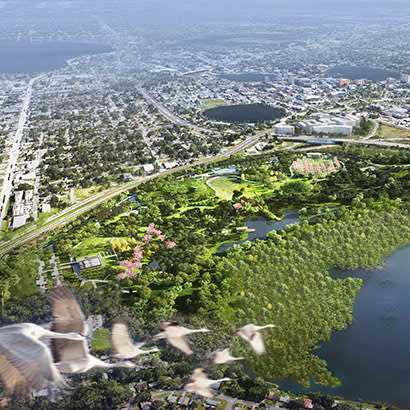
Pristine green spaces in cities are frequently hard to come by, requiring park agencies and designers to think creatively about future parks and conservation. Oftentimes, future park sites present environmental and social challenges that seem daunting to tackle. Perhaps because complex environmental restoration often is needed for parkland, these projects aren’t viewed as economic drivers. Many park sites also cause designers and park agencies to confront an uncomfortable part of urban history: many parks only have been made accessible to more privileged communities and, sometimes, act as a tool to segregate communities. However, each of these complex scenarios presents an opportunity: how can designers work with cities and communities to conserve and restore the environment, ecologically, economically and socially?
The following project from Sasaki looks at how to use conservation as a main driver of form and function, all while achieving the goals of: restoring the environment, reestablishing habitat and, ultimately, connecting people to nature.
Bonnet Springs Park and Lakeland Railyard
Between 1880 and the early 1950s, the site of the future 180-acre Bonnet Springs Park served as one of the most important railroad centers in Florida. The Lakeland Railyard moved, stored and repaired the coal-powered locomotives that fueled the region’s economy. Fast-forward 60 years to today, and you may be surprised by the next iteration of this derelict brownfield site: a public park. Bonnet Springs Park’s visionary mission and technical challenge is to reverse the impacts of the former operations and create a site where the community can escape, engage and explore Central Florida’s incredible ecosystem.
The first major challenge to overcome was removing the arsenic from the 60-acre railyard site. Working closely with state environmental officials and environmental engineers, Sasaki developed a remediation strategy that used the 350,000 cubic yards of contaminated soil to create sculpted landforms on the flat plateau. These capped and safe landforms serve as a reminder of the site’s past and showcase how creative design can overcome years of degradation.
Stormwater Management Design
Land remediation, however, is just one facet of the ecological-improvement strategy. The two major water systems in the future park, Lake Bonnet and Bonnet Springs Valley, face staggering environmental challenges. Lake Bonnet is the most polluted lake in the city, and Bonnet Springs Valley, which drains into Lake Bonnet, is experiencing an accelerated rate of erosion along its banks. This erosion is caused by a 66-inch diameter culvert near the headwaters that releases stormwater runoff from a 300-acre watershed. The Bonnet Springs Park board decided to implement a stormwater-management design that will help restore Bonnet Springs Valley and prevent further pollution of Lake Bonnet.
First, the design separates the commingled stormwater runoff from the clean water coming from the natural sand seep spring. The contaminated water then moves through a series of constructed wetlands to remove pollutants before being released into the lake. Not only do these new wetlands serve an important hydrological function, but they provide a new amenity within the park to teach visitors the importance of a working landscape.
Through careful coordination of soil remediation, hydrological restoration and community engagement, Sasaki and the Bonnet Springs Park board have formed a unified vision of a new public asset that establishes strong civic stewardship across Central Florida. This future park will heal years of environmental neglect while creating a civic space that all of Lakeland can cherish.
Anna Cawrse, PLA, ASLA, is Senior Associate Landscape Architect at Sasaki.

